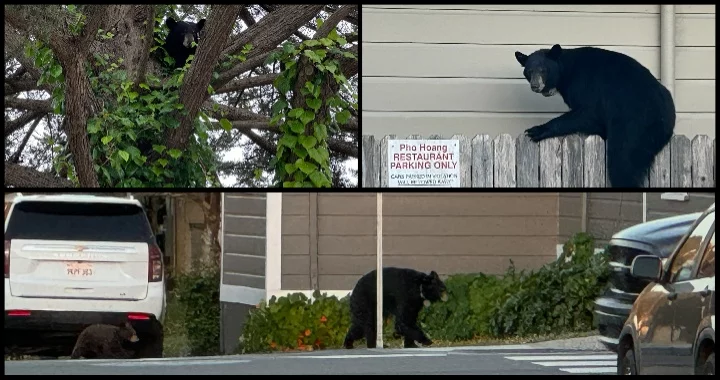Photos, clockwise from upper left: The bears in a tree at Pierson’s (Andrew Goff). The bears raiding Pho Hoang in Arcata (Daniel Pacheco Browning). The bears cruising down Arcata’s G Street (Zachary Meisel). Go home, bears!
Have you, like us, been wondering what happened to the bears removed from the tree by Pierson’s last week? Or if the bears spotted out for a sunset stroll in Arcata on Saturday were the same urban ursidae as the family in the tree?
It’s been a bears-filled couple weeks around here, so Peter Tira, information officer with the California Department of Fish and Wildlife, hopped on the phone with the Outpost to provide a much-needed situation report.
First off, yes – the urban bears camped out in the Pierson’s tree and spotted hopping over the Pho Hoang fence are the same mother and cub. The pair are now in Samoa.
Bears have one of the best senses of smell in the animal kingdom (seven times greater than a bloodhound!), so Tira said that peninsula residents should secure any and all potential smelly attractions: garbage should be tightly lidded, pet food (even chicken feed) kept inside, bird feeders emptied and fruit trees monitored for fallen bear treats.
“We don’t want to see these bears any more comfortable than they already are in urban areas,” Tira said, “we want them to make their way back to the wild.”
After removing the bears from their tree perch on the morning of June 10, CA Fish & Wildlife deposited the family in forested habitat about 30 miles away, according to Tira. The sow (mom) was collared, and Fish & Wildlife’s Northern Region headquarters has been tracking the family’s movements since.
Over the course of last week, the bears crossed Highway 299 near Blue Lake, followed the river to Arcata – making it to Northtown by Saturday evening – and followed the curve of Humboldt Bay out to Manila.
On Tuesday night, the mother bear was struck by a vehicle on the Samoa Peninsula around 10 p.m. The driver reported the incident, including that the bear they hit was collared, and Tira said the sow is injured but still mobile. The cub remains unharmed.
So, why have these bears taken to the urban coastal lifestyle? Simple: They’ve learned that Eureka, Arcata and even more sparsely populated communities like Samoa are hotspots for free food.
“It’s a lot more calories for a lot less work,” Tira said, adding that while bears catching on to the easy snackings of developed areas is common in California, the pair’s return to town is not what Fish & Wildlife wanted to see happen.
If mother and cub become an ongoing problem, Fish & Wildlife will remove them to wild habitat (again), according to Tira.
Sightings can be reported to the Fish & Wildlife Northern Region headquarters at (530) 225-2300 or askregion1@wildlife.ca.gov.
Pictures can also be sent to the Outpost at lostcoastoutpost@gmail.com.

CLICK TO MANAGE